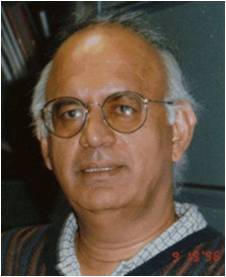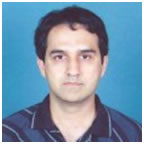|
Keynote Speaker
B. Chandrasekaran (Ohio State University, USA)
Invited Speakers
1. Dr. Sheela Ramanna (University of Winnipeg, Canada)
2. Dr. Karthik Visweswariah (IBM Research, Bangalore, India )
| Dr. B. Chandrasekaran (Keynote Speaker) |
 |
Prof. B. Chandrasekaran
Professor Emeritus
Laboratory for Artificial Intelligence Research
Department of Computer and Information Science
395 Dreese Lab
2015 Neil Avenue
The Ohio State University
Columbus, OH 43210-1277 USA
Email: chandra@cse.ohio-state.edu
Phone: (614) 292-0923 begin_of_the_skype_highlighting
Fax: (614) 292-2911 |
Brief Biography:
B. Chandrasekaran is Professor Emeritus, Senior Research Scientist and Director of the Laboratory for AI Research in the Department of Computer & Information Science at Ohio State University. His major research activities have been in knowledge-based reasoning (especially causal understanding as applied to design and diagnosis), image-based reasoning, architecture of mind, and cognitive science. His work on generic tasks in knowledge-based systems is among the most heavily cited in recent research in the area of knowledge-based systems, as is his work on engineering design and functional reasoning. His current focus is on causal understanding and use of images in problem solving. Chandrasekaran was Editor-in-Chief of IEEE Expert from 1990 to 1994. He co-edited Diagrammatic Reasoning: Cognitive and Computational Perspectives (AAAI Press/ The MIT Press, 1995). From July 2001-Dec 2009, he was part of the US Army Research Laboratories Collaborative
Technology Alliance on Advanced Decision Architectures, which supported his group's research on diagrammatic reasoning, decision architectures and information fusion. He has been elected Fellow of IEEE, AAAI and ACM.
Title: Diagrammatic Reasoning: Giving Perception Its Due in Thinking
Abstract:
AI and cognitive science by and large subscribe to the "Language of Thought" hypothesis, which treats thinking as taking place on a representational substrate made up expressions composed of symbolic predicates. Thus, in much AI work on problem solving as goal-directed reasoning, goals, knowledge, and problem states are all taken to be such representations. On the other hand, phenomenological accounts of our own thought reveal that the cognitive state is multi-modal: In addition to the linguistic component, we also experience, as part of our cognitive state, perceptual images in different modalities. In this talk, I focus on diagrammatic reasoning as a window into general multi-modal cognition. External representations in the form of diagrams are ubiquitous in modern cultures. Cognitive architectures, such as Soar and Act-R, view cognition entirely within the framework of predicate-symbolic representations. However, even when using external diagrams, diagrammatic reasoning calls for the construction of internal diagrams, i.e., diagrammatic imagination. In this talk, I describe DRS, a representation framework that we have been developing for a number of years, to support diagrammatic reasoning and imagination. The work on diagrammatic representations suggests what a more fully developed multi-modal cognitive architecture would look like. |
|
Dr. Sheela Ramanna (Invited Speaker) |
 |
Dr. Sheela Ramanna
Professor and Chair
Dept. of Applied Computer Science
University of Winnipeg
515 Portage Avenue, Winnipeg MB R3B 2E9
Canada
Phone: 204-786-9447 Fax: 204-774-8057
Webpage: http://www.uwinnipeg.ca/~sramanna
Email: s.ramanna@uwinnipeg.ca |
Sheela Ramanna is a Full Professor and head of the Applied Computer Science Department at the University of Winnipeg. She received a Ph.D. in Computer Science from Kansas State University, U.S.A. and a B.E. in Electrical Engineering and M.Tech. in Computer Science and Engineering from Osmania University, Hyderabad, India. She is the Managing Editor for Springer Transactions on Rough Sets Journal (TRS). She serves on the Editorial Board of TRS, Journal of Intelligent Decision Technology (IOS Press), Int. Journal of Advanced Intelligent Paradigms (Inderscience), and Journal of Agents and Multi-Agent Systems. She served as Program Co-Chair for RSKT2011, RSCTC2010 and JRS2007. She is currently co-editing a Springer book on Emerging Paradigms in Machine Learning. Her paper on rough control co-authored with James F. Peters received the IFAC Best Paper Award in 1998. She has served on numerous program committees for international conferences and is a reviewer for several international journals. She has published numerous articles on the theory and application of computational intelligence techniques (rough and near sets, fuzzy sets and neural networks) in journals, conferences, books and edited volumes. She is a member of the Computational Intelligence Laboratory at the University of Manitoba (http://wren.ece.umanitoba.ca/). Her current research interests are focused on computational intelligence techniques in designing perceptual systems.
Title: Sufficiently Near Neighbourhoods in Pattern Analysis
Abstract:
The focus of this talk is on the discovery of approaches in determining nearness (or apartness) of sets of neighbourhoods of points. This discovery process hinges on the recognition of the importance of object descriptions. A particular object description is represented by a feature vector. A determination of sufficient nearness results from considering the distance between descriptions of members in sets of objects to determine the perceived similarity or dissimilarity of the sets. This study has important implications in M. Katetov's approach to topologising the part of a set. The Lowen form of an approach space and the more recent Naimpally-Peters-Tiwari generalised approach space are briefly explained. Two forms of Cech distance are given in this talk (location-based and description-based). This leads to two forms of neighbourhoods of points, namely, traditional spherical (location-based) neighbourhoods from topology and new description-based neighbourhoods of points. A spherical neighbourhood has a center, whereas a description-based neighbourhood has a reference point. A pair of neighbourhoods of points is sufficiently near (apart), provided that the Cech distance between the neighbourhoods is less than (greater than) some number ε. Patterns emerge from the study of sets of neighbourhoods that are sufficiently near or apart, depending on the choice of neighbourhood reference points, radii and extracted features. Some applications such as as detecting anomalies in power system equipment, visual arts (paintings), nearness of rough sets, and content-based image retrieval (CBIR) will be discussed. |
| Dr. Karthik Visweswariah (Invited Speaker) |
 |
Senior Technical Staff Member
IBM Research,
Bangalore, India
Email: v-karthik@in.ibm.com
Phone: +91 997 281 2194 |
Karthik Visweswariah is a Senior Technical Staff Member at IBM Research, India. His primary interests are in statistical modelling applied to text and speech. Prior to joining IBM Research, India in 2008 he spent 8 years at IBM's T.J. Watson Research Centre in the Human Language Technologies group working on improving speech recognition technologies in IBM's products. His current focus is on improving machine translation for translating between Indian languages and English. He has published over 60 papers in these areas in various refereed journals and conferences. He obtained his Ph.D from Princeton University in 1999 and B.Tech from Indian Institute of Technology, Madras.
Title: Building Watson: An overview of the DeepQA project
Abstract:
A computer system that aims to beat the best humans at the Jeopardy challenge needs to be able to provide high precision answers to open domain questions in under three seconds while knowing when it knows. In this talk, we will briefly describe the Jeopardy challenge and give an overview of the DeepQA architecture that enables high precision and speed by using a highly parallel architecture capable of generating and evaluating evidence for thousands of hypotheses. |
|


